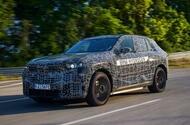What Makes the BMW iX5 Hydrogen Stand Out in a Crowded SUV Market?
If you’ve been following the evolution of eco-friendly cars, you know the landscape is changing fast. BMW’s latest announcement about the iX5 Hydrogen isn’t just another headline—it’s a real turning point. For the first time, BMW is set to offer its flagship X5 SUV with five different powertrains: petrol, diesel, plug-in hybrid, battery-electric, and, yes, hydrogen fuel cell. That’s a bold move, and it says a lot about where the brand sees the future of driving.
But what actually sets the iX5 Hydrogen apart? For starters, it’s not just a concept or a limited-run experiment. BMW plans to sell this hydrogen-powered SUV alongside its traditional and electric siblings, giving buyers more choice than ever. That’s a big deal for anyone who wants to go green but isn’t sold on battery-electric vehicles (BEVs) just yet.
How Does Hydrogen Power Work in the iX5—and Why Should You Care?
Let’s break it down. Hydrogen fuel cell vehicles (FCEVs) generate electricity by combining hydrogen with oxygen, producing only water vapor as a byproduct. The iX5 Hydrogen uses a third-generation fuel cell stack, co-developed with Toyota, that’s about 25% smaller than previous versions but packs more punch. That means better efficiency and more power in a smaller, lighter package.
BMW’s new high-voltage control unit, the Energy Master, is another leap forward. It manages the flow of electricity from the fuel cell to the electric motor, optimizing performance and efficiency. The outcome? A smoother, more responsive drive that doesn’t compromise on range or power.
What’s the Real-World Performance Like?
While BMW hasn’t released final specs for the production model, they’ve set the bar high. The previous iX5 Hydrogen prototype delivered 396 horsepower and a range of around 313 miles (504 km) on a full tank—enough for most road trips without the range anxiety that sometimes comes with BEVs.
It’s worth noting that hydrogen refueling is fast—typically taking just a few minutes, similar to filling up with petrol or diesel. That’s a major advantage for drivers who don’t want to wait around for a battery to charge, especially on long journeys.
How Does the iX5 Hydrogen Fit Into BMW’s Broader Strategy?
BMW’s decision to launch the iX5 Hydrogen as part of its fifth-generation X5 lineup isn’t just about offering another powertrain. It’s about flexibility. As Joachim Post, BMW’s R&D chief, put it, the goal is to meet diverse customer needs around the globe. Some regions have robust charging infrastructure for BEVs; others are investing heavily in hydrogen. By offering both, BMW is hedging its bets—and giving buyers options.
The iX5 Hydrogen will be built on BMW’s proven Cluster Architecture (CLAR), not the new Neue Klasse EV platform. That means it shares its bones with other X5 models, making it easier and more cost-effective to produce at scale. Production of key components is set to begin in 2028 at BMW’s plants in Steyr, Austria, and Landshut, Germany—both facilities known for their engineering expertise.
What’s New Inside the Cabin?
Step inside the prototype, and you’ll notice some big changes. There’s a full-width head-up display and a massive 17.9-inch central infotainment screen—both inspired by BMW’s Neue Klasse design language. The familiar iDrive rotary controller is on its way out, replaced by touch and voice controls for a more intuitive, modern experience.
It’s clear BMW is thinking about the future, not just under the hood but in the driver’s seat, too. The blend of high-tech features and sustainable power makes the iX5 Hydrogen feel like a glimpse of what’s next for luxury SUVs.
Is Hydrogen Really the Future—or Just a Niche Option?
This is the million-dollar question. Hydrogen vehicles have long been touted as a solution for long-range driving and quick refueling, especially in places where charging infrastructure is limited. According to the International Energy Agency, global hydrogen production for energy reached about 94 million tonnes in 2022, and investment in hydrogen refueling stations is ramping up, especially in Europe and Asia.
Still, challenges remain. Hydrogen production is energy-intensive, and the infrastructure for refueling is nowhere near as widespread as electric charging stations. But with major automakers like BMW and Toyota pushing ahead, the tide could be turning. If governments and industry partners keep investing, hydrogen could become a mainstream option—especially for larger vehicles like SUVs and trucks.
What Does This Mean for Drivers Who Want to Go Green?
If you’re considering a switch from petrol or diesel, the iX5 Hydrogen offers a compelling alternative. It combines the convenience of fast refueling with zero tailpipe emissions and the driving dynamics BMW is known for. For those who aren’t ready to go fully electric—or who live in regions where charging is a hassle—hydrogen could be the sweet spot.
Of course, the real test will come when the iX5 Hydrogen hits the market in 2028. Will buyers embrace it? Will infrastructure keep pace? Only time will tell. But one thing’s clear: BMW is betting big on a future where drivers don’t have to compromise between sustainability, performance, and convenience.
The Bottom Line: A New Era for Sustainable SUVs
BMW’s iX5 Hydrogen isn’t just another SUV—it’s a statement about the future of mobility. By offering a full spectrum of powertrains, BMW is giving drivers real choices and pushing the industry toward a more flexible, sustainable future. Whether hydrogen becomes the dominant technology or remains a niche player, the iX5 Hydrogen is proof that innovation in the auto world is alive and well. And for drivers who want to be part of that next chapter, it’s an exciting time to be behind the wheel.

